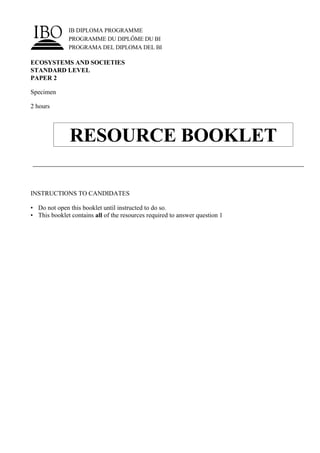The document provides information on threats facing coral islands. It discusses how climate change is causing coral bleaching and death as ocean temperatures rise. Overfishing disrupts ecosystems by removing too many fish. Pollution from sewage, chemicals and sedimentation harms corals by reducing water quality and smothering reefs. Uncontrolled tourism damages reefs through activities like walking on coral, collecting specimens, boat anchors damaging reefs, and untreated sewage from hotels polluting the ocean. These threats endanger the fragile coral ecosystems that many species depend on.





![–5–
Figure 5 — Vulnerability to extinction
Listed below are the criteria that may lead to a species being at risk from extinction.
• Species with a narrow geographical range
• Species with a single population (or a few populations)
• Species with a small population size
• Species with a low population density
• Species with a large body size
• Species with low rates of population growth
• Migratory species
• Species with little genetic variation
• Species requiring specialized niche environments
• Large home range
Adapted from Richard B. Primack (1993) Essentials of Conservation Biology, pub. Sinaur
Figure 6 — Ningaloo; a coral island in danger
Media Release, Saturday, 27 November 2004 - People power and science deliver right formula for
Ningaloo
The Save Ningaloo Campaign today welcomed the Government’s decision to increase
protection at Ningaloo Reef. The outcome goes a long way to fulfilling the aspirations
of many tens of thousands of people who have called for better protection of Ningaloo.
Paul Gamblin, Save Ningaloo Campaign spokesperson, said, “By placing 34% of
Ningaloo Reef in sanctuary zones, the Western Australian Government has heeded the
call of the community and the advice of the world’s leading coral reef scientists.”
The new plan allows for recreational fishing in two thirds of the marine park while
setting aside one-third for the preservation of natural ecosystems.
“The vast majority of recreational fishers understand that Ningaloo needs reasonable
levels of protection, and will support this move.”
“This plan has provided the Reef with an insurance policy against the serious threats
facing coral reefs worldwide.”
“The increased sanctuary zones and funding for management are critical to protecting
Ningaloo for future generations, and we commend the Government for these
responsible steps”.
[Source: Paul Gamblin (2004), Save Ningaloo Campaign, http://www.save-ningaloo.org]
Turn over](https://image.slidesharecdn.com/specimenresourcebooklet-130201051835-phpapp02/85/Specimen-resource-booklet-6-320.jpg)
![–6–
Figure 7 — Threats to coral islands
Over fishing 45 45
Marine based
87 10 low threat
pollution
medium threat
Sedimentation 65 12 high threat
Coastal
73 15
development
0% 20% 40% 60% 80% 100%
Figure 7a. Caribbean Islands; threats to coral
100%
6
90% 16 10
80%
70%
54
60% high threat
50% medium threat
92
40% 80 82 low threat
30%
20% 36
10%
0%
Over fishing
development
Marine based
Sedimentation
Coastal
pollution
Figure 7b. Indonesian Islands: Threats to Coral
[Source: Lauretta Burke and Jon Maidens and contributing authors (2004) Reefs at Risk in the
Carribean.: http://reefsatrisk.wri.org/casestudy_text.cfm?ContentID=3039]](https://image.slidesharecdn.com/specimenresourcebooklet-130201051835-phpapp02/85/Specimen-resource-booklet-7-320.jpg)

![–8–
Pollution and sedimentation
Some of the biggest problems facing the coral reefs come from the land. Corals are
threatened by pollution in many forms, including oil slicks, sediments, fertilizers,
pesticides and other chemicals, heavy metals, and garbage. A nasty cocktail of
chemicals is carried in the rivers and even in pipes, and winds up near the coral reefs.
Human sewage, one of the most common problems for the reefs, encourages the growth
of certain types of large algae or seaweed. These grow much better than the corals and
can smother or kill them by shading them out of existence.
In many parts of the world people are chopping down forests and plowing up the land.
A great deal of soil is being washed off the land, into the rivers and from the rivers to
the sea. When there is a lot of mud in the water it cuts out the light. This mud or
“sediment” sinks down and creates muddy ooze on the bottom of the ocean. Corals need
bright clear waters to get the sunlight they need, and also hard surfaces to grow on. This
sediment stops new corals from growing, and can smother and suffocate the existing
corals.
Tourism
Coral reefs attract millions of visitors, but uncontrolled tourism and coastal
development have caused pollution and resulted in heavy damage to the reefs. Too
many irresponsible visitors damage or destroy corals by touching, walking or standing
on them. Many tourists collect and/or buy corals, sponges, seashells or other reef
animals as well as jewelry and sculptures made out of them. Excessive collecting
decimates the reef species and throws reef ecosystems out of balance. Hotels and resorts
contribute to water pollution by not properly treating their sewage and wastewater, and
many tourist boats crush coral while throwing their anchors onto reefs, or spill oil and
gas into the sea.
[source:http://www.oceanwonderland.com/threats.htm (no author stated)]](https://image.slidesharecdn.com/specimenresourcebooklet-130201051835-phpapp02/85/Specimen-resource-booklet-9-320.jpg)